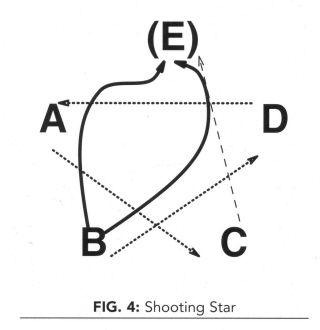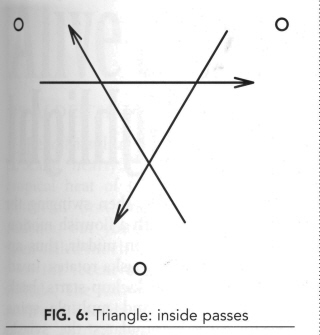|
Now
you may have noticed that C and D have pretty easy roles (a mere
4-count, although their incoming passes come from different places
at different times, making it more interesting). So if you want to
really spice up the pattern, add one more club and have C and D pass
it back and forth as a triple. Essentially C and D will be passing 7
clubs with triples in a 4-count, but instead of doing selves,
they'll be passing to B and A respectively. Use the sequences in
Fig. 3 except replace each self that C or D has with a triple to D
or C. The person who normally starts with a self (D in Fig. 3)
starts with the extra club, throwing it on beat 1 as a triple to C.
Keep those triples outside for safety purposes.
Shooting
Star The
Shooting Star is a pattern you can do when you wanted to do a
five-person star but one person didn't show up and another didn't
bring any clubs. This pattern, invented by Bryan Olson of Baltimore,
Md., involves a lot of running through the star by the star's own
points.
Arrange your four people in four of the five positions of a star, leaving the fifth position empty (Fig. 4). Each of you passes to the second person on your right. The person whose receiver is initially missing starts with no clubs (since there is no one to catch them). Everyone else starts with three clubs. In Fig. 4, juggler C starts with no clubs because juggler E is missing.
Now
you do a normal right handed star, passing a 2-count. The person who
starts with no clubs will find clubs coming in (from the second
person on the left) and should start juggling them and be ready to
pass them when they get to the right hand. Fortunately just as this
person starts to pass, to the position that was initially empty,
someone will magically appear in that position to catch the clubs.
That's the trick of this pattern.
What
happens is this. When a clubless person starts receiving clubs,
another person starts running out of clubs because of the empty
position. Whenever you run out of clubs
in this pattern, you immediately move to the position in the star
that was empty the position that would have been passing to you,
namely two to your left. Just as you get there, a club will arrive
too, and you just start juggling again, passing a 2-count like
everyone else, to the person two to the right (where you used to
be!).
The
question is, how do you safely get from one position to another in
the star while people are passing clubs through it? You start
through just after a club has gone by in front of your face, but
there are two routes you can take to your destination-the direct
fast route and the indirect sauntering route.
Let's
say that you are B in Fig. 4 and you want to saunter over to E.
After you pass your last club, wait for the club from the person on
your left (A) to go by and then move straight forward into the
middle of the star. Once in the middle, keep moving in and turn to
the right, towards C. Intercept C's next pass somewhere in the
middle and back out, following that club's route out of the middle
to E.
It's
important not to cross D's line of fire until you've caught the club
from C, and then you back out of the middle through the same point
where that club from C would have gone. That gets you out without
colliding with the club from D. Once out, face the position you came
from (B) so that you can be ready to pass to there once you get
enough clubs from C. With this route, you don't have to move too
fast.
You
can, instead of sauntering, shoot straight from B to E, cutting
pretty close to A on your left. After you make your last pass, as
usual wait for the club from A to go by and then watch nothing but
the clubs coming from D. Those are the clubs that can nail you. In
fact, I start out by watching D pass and just notice Ns pass go by
without really looking at it. This lets me know where D's club is
without having to locate it at the last minute. After you go right
behind the club from A, you go right behind the club that D threw at
the same time. As you run close by A directly to E, stare directly
at that club from D-if you don't, it may stare directly into your
head.
Once
you get safely outside the star, past D's line of fire, look quickly
into the star toward C and you'll find a club quickly approaching
where your left hand should end up. Catch the club, face your old
position B, and resume juggling.
This
direct fast movement is more exciting than the slow, almost
laid-back, sauntering move described earlier, although it gets you
to the same place. It's up to you which one you use - some people
are more comfortable sauntering through the star rather than
shooting through. Note that in the fast move you go behind D's first
pass, whereas in the slow move, you go behind D's second pass.
By
its nature, the Shooting Star requires that a new person move
shortly after the previous person. You can't just hang around
waiting for your nerve to build up. In fact, if you use the basic
nine clubs, then on every third pass someone has to move. Once
you've
Finally,
you can add an eleventh club, in which case someone will have to
move on every pass, taking along two clubs, and each person will
have to move once every four passes. To start the ten or eleven club
versions, give the extra clubs to the person who would have started
with none if there were only nine clubs.
One
more useful note. When you're the person who had no clubs and you're
just now beginning to pass, you'll find that you're facing an empty
position. Don't pay any attention to the runner - just pass normally
to the empty position as if someone were there. Don't try to figure
out where the runner might be. Just pass assuming the runner will be
perfectly positioned outside the star by the time your pass gets
there.
By
the way, you'll find, as you shoot around the star, that you're
always passing to the same person, who of course is often getting
there just in time. The
Double Triangle This
is a well established and not too difficult pattern for four people.
Basically, on each beat, three of the people pass right handed in a
triangle while the fourth person does a self.
A triangle can be done with inside passes or outside passes (or possibly switching back and forth). An outside pass is a pass that stays on the outside of the triangle (Fig. 5), whereas an inside pass cuts across the triangle (Fig. 6). I'll describe the Double Triangle here with outside passes, but if you reverse the directions of the passes, you get the double triangle with inside passes. ("Reverse the directions" means wherever it says A passes to B, change that to mean B passes to A.) All the passes here are right hand passes, although triangles are natural patterns for passing with both hands (e.g., see the Collected Nightmares referenced above and also the Spring 1993 Juggler's Workshop).
|


